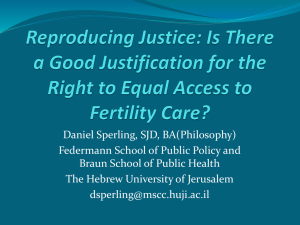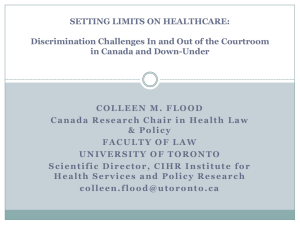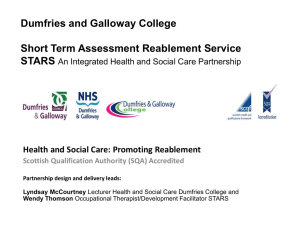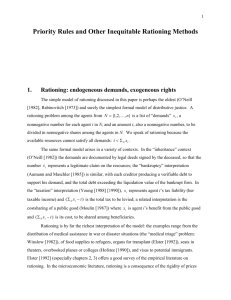the impact of eligibility criteria on prevention
advertisement
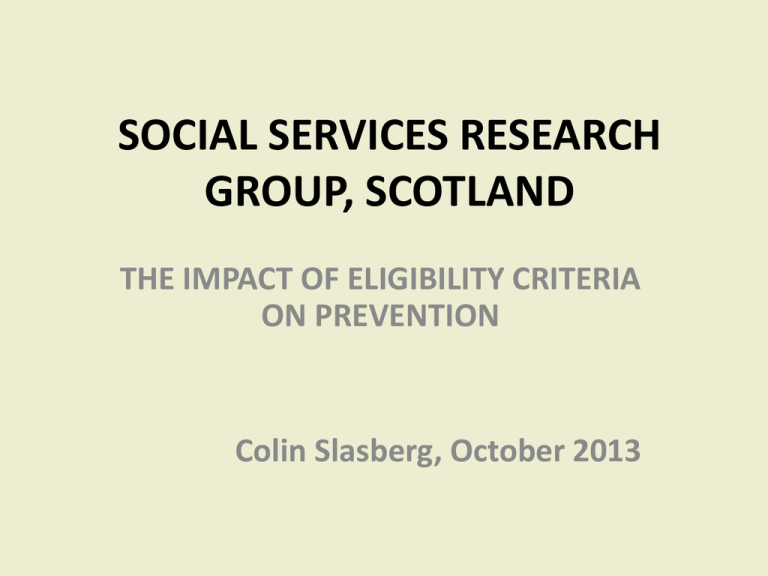
SOCIAL SERVICES RESEARCH GROUP, SCOTLAND THE IMPACT OF ELIGIBILITY CRITERIA ON PREVENTION Colin Slasberg, October 2013 LEVELS OF PREVENTION (ADSW, 2010) Primary Aimed at people who have little or no particular social care needs or symptoms of illness. The focus is therefore on maintaining independence and good health and promoting wellbeing Non assessed services and community development Secondary Targeted services Aims to identify people at risk and to halt or slow down any deterioration, and actively seek to improve their situation. Tertiary Aimed at minimising disability or deterioration from established health conditions or complex social care needs. The focus here is on maximising people’s functioning and independence Continuing support; • which needs are met • how they are met THE IMPORTANCE OF TERTIARY PREVENTION Leicestershire seen as the leading exemplar of secondary prevention through reablement. CSIP reported that staff were concerned how their good work was undermined when people returned to on-going support. Their concern is supported by the following evidence Between 200 and 2008, England increased provision of home care by 46.2% and Leicestershire 54.2%. Over the same period, the number of permanent residents nationally fell by 10.9%, but only by 3.8% in Leicestershire. NICE stake holder report re standards in home care, 2013 “There was wide agreement across the groups that it was imperative for it reablement to be included but broad consensus - and strong feeling - that reablement and homecare cannot be distinguished from one another, i.e. that reablement ought to be considered as an outcome and philosophy that should underpin all aspects and stages of homecare” ELIGIBILITY CRITERIA AND TERTIARY PREVENTION • There are two distinct issues that diminish tertiary prevention; 1. Insufficient resource, with priority inevitably given to burning fires 2. The way the scarce resource is allocated – the rationing process • Change should begin with the second for the following reasons; • It is within grasp, as it does not require more resources • A reformed rationing process can create a more sure path toward a better political settlement for social care INSUFFICIENT RESOURCE • A service based view is not sound, that lower level services have a preventive impact is not sound. John Bolton draws attention to two studies that disprove the assumption that low level services have preventive value; Canadian study Seniors receiving preventive home care were about 120 per cent more likely to lose their independence than seniors not receiving preventive home care PSSRU study Councils whose FACS threshold was moderate or low had higher levels of state funded admissions to residential care than those that had critical or substantial criteria (Forder, 2007) • However, it may be reasonable to believe a needs based view is sound, and that people whose dignity, sense of self worth and self fulfilment are low are less likely to maintain motivation THE RATIONING PROCESS CSCI said the following of England’s system of resource rationing – ‘FACS’ – in 2008; • Leads to unduly standardised assessments • FACS was an attempt to move away from a service–led approach to support, ie where people are fitted into available services, but evidence confirms earlier findings of the continuing influence of such a model • the FACS framework encourages a focus on what cannot be done by individuals (a deficit model) rather than on what they could do with support and what outcomes people want to achieve • The system does not help us deal with the needs of people below the eligibility threshold, yet this is preventative services territory (ADASS) ANALYSING THE REASONS • Assessments serve the resource rationing process, which is the priority concern of service users and council. The resource rationing process thus becomes the dominant driver in shaping how assessments are carried out. • FACS is based on a flawed concept; • The variability of individual need and the costing of meeting them makes notion of being able to band needs and predict the cost of meeting each band is undeliverable. • This is mitigated at the operational level by the assessment delivering the resource rationing process supposed to be delivered strategically. This is made possible by high levels of elasticity in how the bands are interpreted. This results in an appearance of equity whilst concealing major inequity, both between councils and between user groups as historically set budgets determine eligibility. DAMAGE TO THE ASSESSMENT PROCESS • • • • The scope of the assessment is narrowed to affordable needs, with fear of declaring any other needs ‘eligible’. Panels police the assessors and further reduce assessments where they feel able to Weight of dependency is the most persuasive currency. This encourages the deficit model Needs expressed as services are most easily costed Outcomes are not relevant to the decision WHAT NEEDS TO BE DIFFERENT Six requirements of an eligibility framework • • • • • • • Enables spend to be matched to budget A robust approach to prioritising needs to enable consistency without compromising the uniqueness of each person An accessible approach to prioritising needs to enable real user engagement Enables needs at all levels of priority a chance of being funded Enables a true measure of equity Generates information about the actual cost of delivering the vision of a care and support system that enables independence and well-being for all Creates a progressive assessment process HOW CAN THIS BE ACHIEVED Two key innovations to deliver the requirement: 1. Prioritise personal needs in the here and now by reference to the universal human needs, eg • Survival • Safe and well • Self worth • Self fulfilment 2. Distinguish eligibility and affordability and thus separate the process of assessment and the process of resource allocation THE PROCESS OF ASSESSMENT STRATEGIC OUTCOME PEOPLE HAVE THE SAME FREEDOM, CHOICE, DIGNITY AND CONTROL AS OTHER CITIZENS AT HOME, AT WORK, AND IN THE COMMUNITY Increasing immediate priority THE ASSESSMENT PERSONAL NEEDS THE PROCESS OF RESOURCE ALLOCATION Council/user group one Council/user group two Key Needs met Survival DUTY Needs not met • Equity is measured by the proportion of eligible needs met at the discretionary levels. This also exposes unmet need. • Once duty is met, budget holders can take into account immediate priority AND preventive capability armed with outcome based assessments Keeping safe Needs eligible for public funding Self worth DISCRETION Self fulfilment Needs not eligible for public funding Needs that would enable a level of independence and well being above what would be expected by most people Needs that would fall to be eligible but it is appropriate and reasonable for the person or those around them to meet IMPACT ON TERTIARY PREVENTION • Needs in relation to continuing support that identify outcomes are the essential first step in flexible and responsive provision, commissioned to deliver outcomes • Needs that are about quality of life are recognised for what they are, have preventive potential, and have a chance of being funded in the short term • Anticipatory needs can be identified with a chance of being funded • Unmet need is exposed and costed, with potential impact on political processes and improved longer term funding settlements THE CHALLENGES • There will be two key challenges; • Developing the professional skill base. Assessments will need to be capable of identifying personal needs accurately. This has to replace the prevailing culture of standardising and objectifying needs • Political integrity. The system needs to be willing to acknowledge the funding gap and need to reduce it, albeit over time. This has to replace the prevailing culture of denial, supported by professional practices that repress information about unmet need.



